Strategic Management Plan for Unilever: Competitive Edge Analysis
VerifiedAdded on 2023/06/07
|18
|5065
|482
Report
AI Summary
This report provides a detailed analysis of Unilever's strategic plan, examining its market position and competitive advantages within the consumer goods and retail sector. It employs frameworks such as PESTEL, SWOT, McKinsey's 7s, and VRIO to assess the macro and micro environmental factors influencing Unilever's strategies. The report evaluates Unilever's competitive forces using Porter's Five Forces model, and interprets strategic planning using various theories and concepts. It further discusses Unilever's strategic management plan using the SOSTAC model, highlighting tangible strategic priorities and objectives aimed at improving competitive edge and market position. The analysis includes critical evaluation of internal capabilities, identification of strengths and weaknesses, and recommendations for strategic directions and tactical actions.
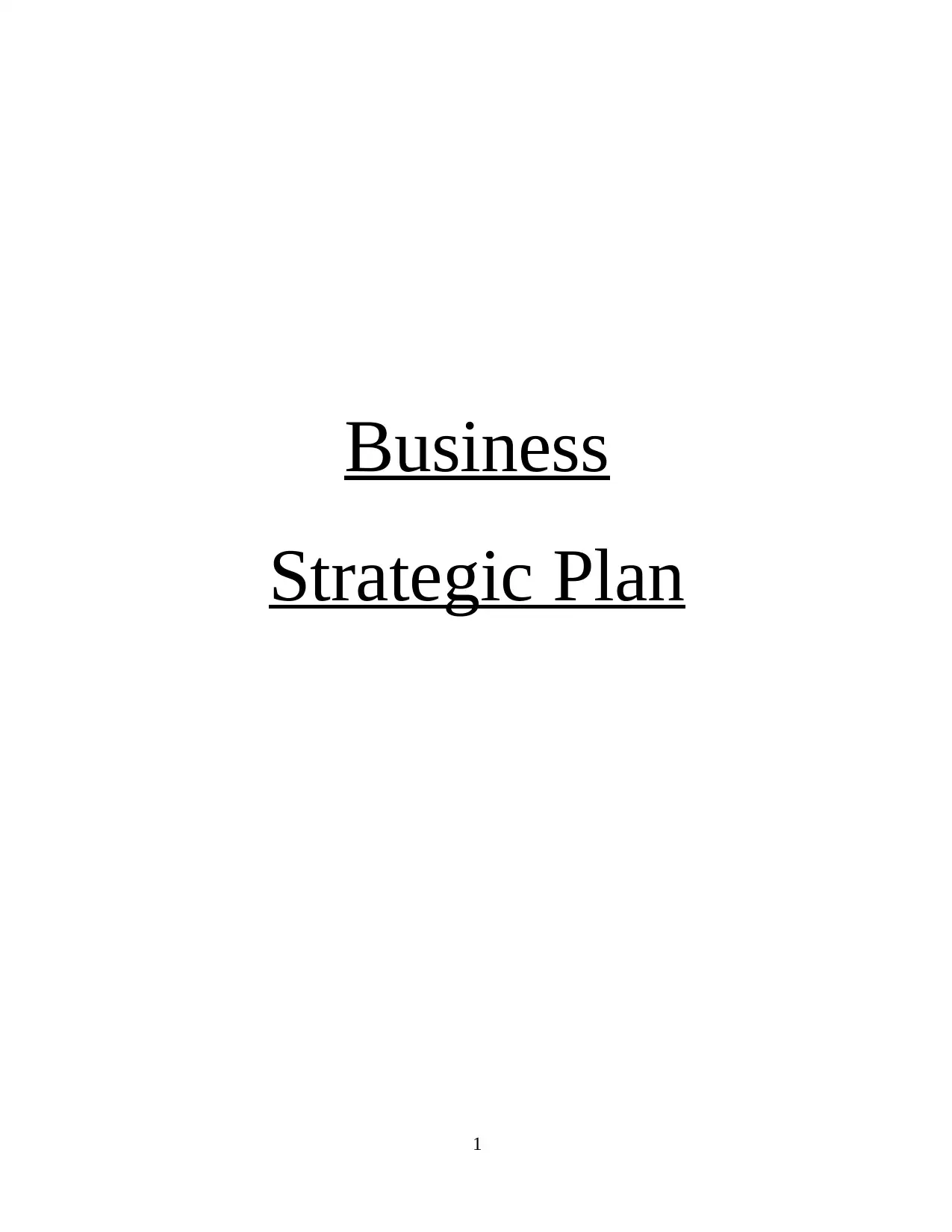
Business
Strategic Plan
1
Strategic Plan
1
Paraphrase This Document
Need a fresh take? Get an instant paraphrase of this document with our AI Paraphraser
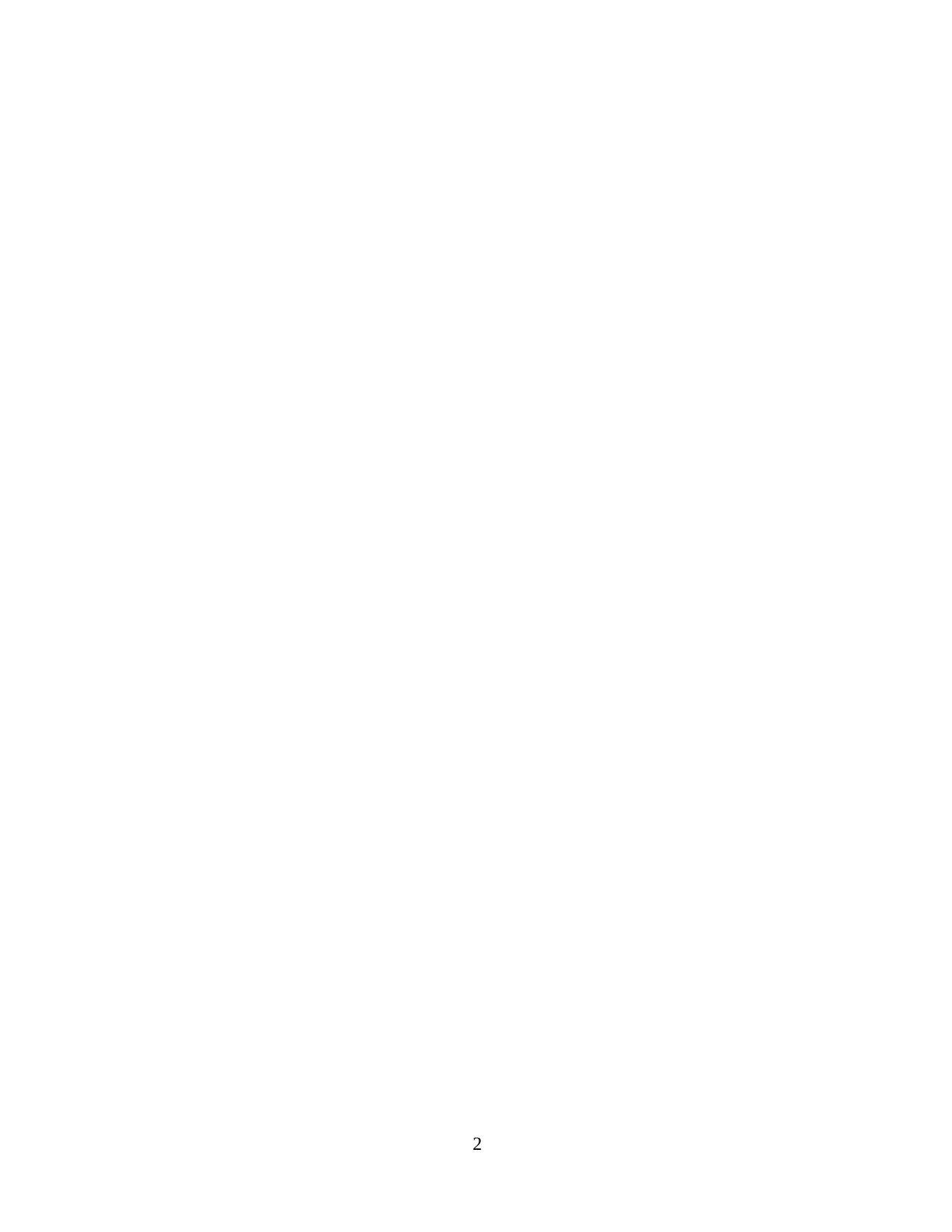
2
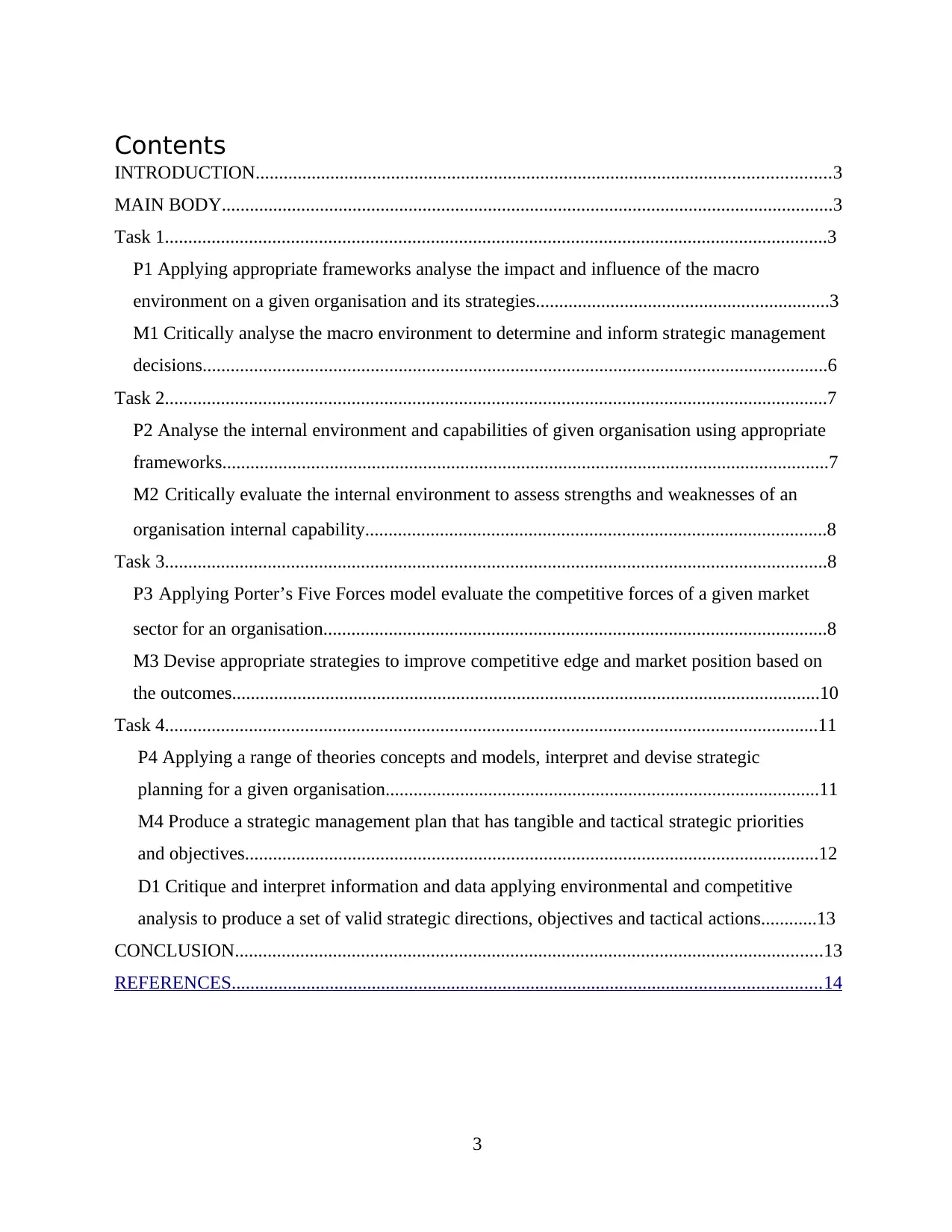
Contents
INTRODUCTION...........................................................................................................................3
MAIN BODY...................................................................................................................................3
Task 1..............................................................................................................................................3
P1 Applying appropriate frameworks analyse the impact and influence of the macro
environment on a given organisation and its strategies...............................................................3
M1 Critically analyse the macro environment to determine and inform strategic management
decisions......................................................................................................................................6
Task 2..............................................................................................................................................7
P2 Analyse the internal environment and capabilities of given organisation using appropriate
frameworks..................................................................................................................................7
M2 Critically evaluate the internal environment to assess strengths and weaknesses of an
organisation internal capability...................................................................................................8
Task 3..............................................................................................................................................8
P3 Applying Porter’s Five Forces model evaluate the competitive forces of a given market
sector for an organisation............................................................................................................8
M3 Devise appropriate strategies to improve competitive edge and market position based on
the outcomes..............................................................................................................................10
Task 4............................................................................................................................................11
P4 Applying a range of theories concepts and models, interpret and devise strategic
planning for a given organisation.............................................................................................11
M4 Produce a strategic management plan that has tangible and tactical strategic priorities
and objectives...........................................................................................................................12
D1 Critique and interpret information and data applying environmental and competitive
analysis to produce a set of valid strategic directions, objectives and tactical actions............13
CONCLUSION..............................................................................................................................13
REFERENCES..............................................................................................................................14
3
INTRODUCTION...........................................................................................................................3
MAIN BODY...................................................................................................................................3
Task 1..............................................................................................................................................3
P1 Applying appropriate frameworks analyse the impact and influence of the macro
environment on a given organisation and its strategies...............................................................3
M1 Critically analyse the macro environment to determine and inform strategic management
decisions......................................................................................................................................6
Task 2..............................................................................................................................................7
P2 Analyse the internal environment and capabilities of given organisation using appropriate
frameworks..................................................................................................................................7
M2 Critically evaluate the internal environment to assess strengths and weaknesses of an
organisation internal capability...................................................................................................8
Task 3..............................................................................................................................................8
P3 Applying Porter’s Five Forces model evaluate the competitive forces of a given market
sector for an organisation............................................................................................................8
M3 Devise appropriate strategies to improve competitive edge and market position based on
the outcomes..............................................................................................................................10
Task 4............................................................................................................................................11
P4 Applying a range of theories concepts and models, interpret and devise strategic
planning for a given organisation.............................................................................................11
M4 Produce a strategic management plan that has tangible and tactical strategic priorities
and objectives...........................................................................................................................12
D1 Critique and interpret information and data applying environmental and competitive
analysis to produce a set of valid strategic directions, objectives and tactical actions............13
CONCLUSION..............................................................................................................................13
REFERENCES..............................................................................................................................14
3
⊘ This is a preview!⊘
Do you want full access?
Subscribe today to unlock all pages.

Trusted by 1+ million students worldwide
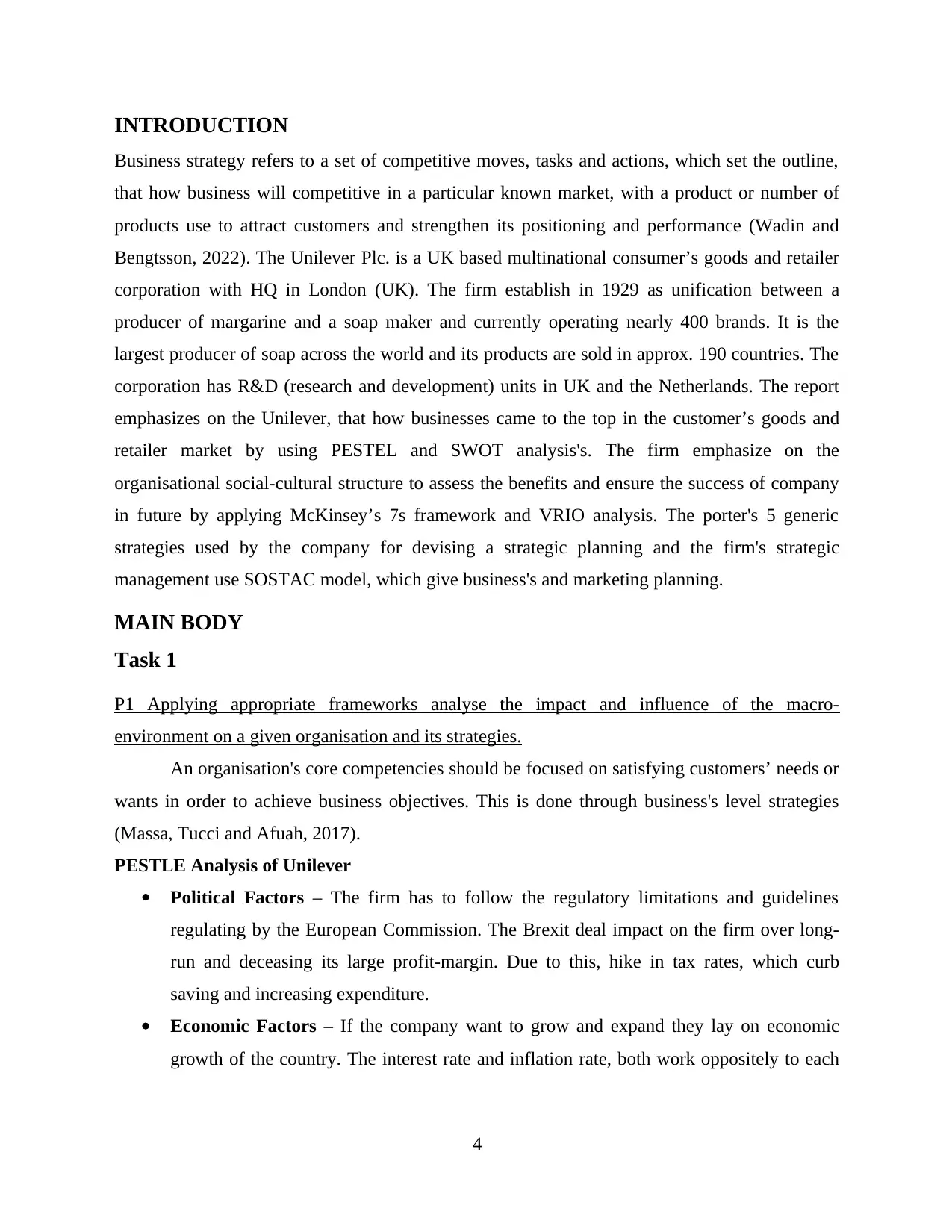
INTRODUCTION
Business strategy refers to a set of competitive moves, tasks and actions, which set the outline,
that how business will competitive in a particular known market, with a product or number of
products use to attract customers and strengthen its positioning and performance (Wadin and
Bengtsson, 2022). The Unilever Plc. is a UK based multinational consumer’s goods and retailer
corporation with HQ in London (UK). The firm establish in 1929 as unification between a
producer of margarine and a soap maker and currently operating nearly 400 brands. It is the
largest producer of soap across the world and its products are sold in approx. 190 countries. The
corporation has R&D (research and development) units in UK and the Netherlands. The report
emphasizes on the Unilever, that how businesses came to the top in the customer’s goods and
retailer market by using PESTEL and SWOT analysis's. The firm emphasize on the
organisational social-cultural structure to assess the benefits and ensure the success of company
in future by applying McKinsey’s 7s framework and VRIO analysis. The porter's 5 generic
strategies used by the company for devising a strategic planning and the firm's strategic
management use SOSTAC model, which give business's and marketing planning.
MAIN BODY
Task 1
P1 Applying appropriate frameworks analyse the impact and influence of the macro-
environment on a given organisation and its strategies.
An organisation's core competencies should be focused on satisfying customers’ needs or
wants in order to achieve business objectives. This is done through business's level strategies
(Massa, Tucci and Afuah, 2017).
PESTLE Analysis of Unilever
Political Factors – The firm has to follow the regulatory limitations and guidelines
regulating by the European Commission. The Brexit deal impact on the firm over long-
run and deceasing its large profit-margin. Due to this, hike in tax rates, which curb
saving and increasing expenditure.
Economic Factors – If the company want to grow and expand they lay on economic
growth of the country. The interest rate and inflation rate, both work oppositely to each
4
Business strategy refers to a set of competitive moves, tasks and actions, which set the outline,
that how business will competitive in a particular known market, with a product or number of
products use to attract customers and strengthen its positioning and performance (Wadin and
Bengtsson, 2022). The Unilever Plc. is a UK based multinational consumer’s goods and retailer
corporation with HQ in London (UK). The firm establish in 1929 as unification between a
producer of margarine and a soap maker and currently operating nearly 400 brands. It is the
largest producer of soap across the world and its products are sold in approx. 190 countries. The
corporation has R&D (research and development) units in UK and the Netherlands. The report
emphasizes on the Unilever, that how businesses came to the top in the customer’s goods and
retailer market by using PESTEL and SWOT analysis's. The firm emphasize on the
organisational social-cultural structure to assess the benefits and ensure the success of company
in future by applying McKinsey’s 7s framework and VRIO analysis. The porter's 5 generic
strategies used by the company for devising a strategic planning and the firm's strategic
management use SOSTAC model, which give business's and marketing planning.
MAIN BODY
Task 1
P1 Applying appropriate frameworks analyse the impact and influence of the macro-
environment on a given organisation and its strategies.
An organisation's core competencies should be focused on satisfying customers’ needs or
wants in order to achieve business objectives. This is done through business's level strategies
(Massa, Tucci and Afuah, 2017).
PESTLE Analysis of Unilever
Political Factors – The firm has to follow the regulatory limitations and guidelines
regulating by the European Commission. The Brexit deal impact on the firm over long-
run and deceasing its large profit-margin. Due to this, hike in tax rates, which curb
saving and increasing expenditure.
Economic Factors – If the company want to grow and expand they lay on economic
growth of the country. The interest rate and inflation rate, both work oppositely to each
4
Paraphrase This Document
Need a fresh take? Get an instant paraphrase of this document with our AI Paraphraser
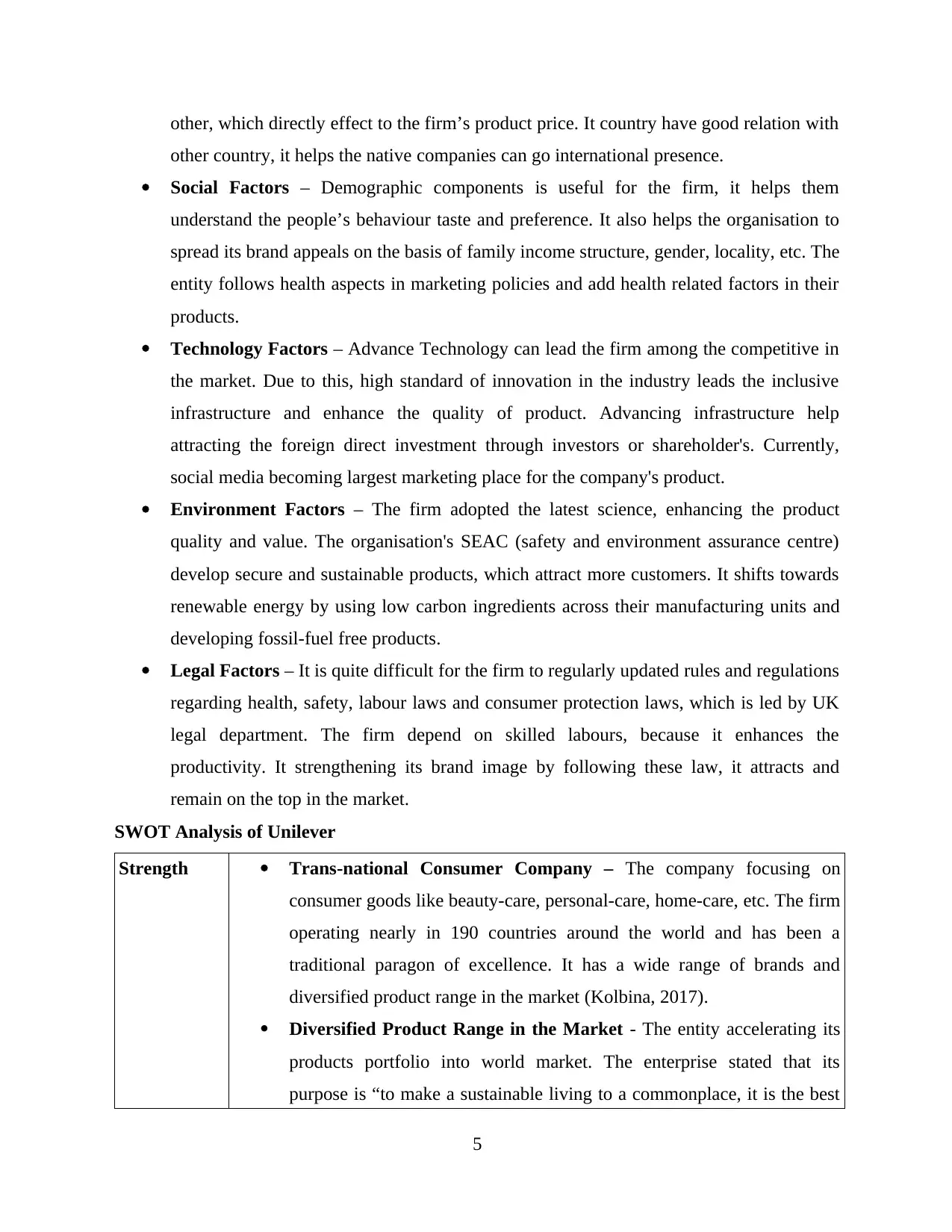
other, which directly effect to the firm’s product price. It country have good relation with
other country, it helps the native companies can go international presence.
Social Factors – Demographic components is useful for the firm, it helps them
understand the people’s behaviour taste and preference. It also helps the organisation to
spread its brand appeals on the basis of family income structure, gender, locality, etc. The
entity follows health aspects in marketing policies and add health related factors in their
products.
Technology Factors – Advance Technology can lead the firm among the competitive in
the market. Due to this, high standard of innovation in the industry leads the inclusive
infrastructure and enhance the quality of product. Advancing infrastructure help
attracting the foreign direct investment through investors or shareholder's. Currently,
social media becoming largest marketing place for the company's product.
Environment Factors – The firm adopted the latest science, enhancing the product
quality and value. The organisation's SEAC (safety and environment assurance centre)
develop secure and sustainable products, which attract more customers. It shifts towards
renewable energy by using low carbon ingredients across their manufacturing units and
developing fossil-fuel free products.
Legal Factors – It is quite difficult for the firm to regularly updated rules and regulations
regarding health, safety, labour laws and consumer protection laws, which is led by UK
legal department. The firm depend on skilled labours, because it enhances the
productivity. It strengthening its brand image by following these law, it attracts and
remain on the top in the market.
SWOT Analysis of Unilever
Strength Trans-national Consumer Company – The company focusing on
consumer goods like beauty-care, personal-care, home-care, etc. The firm
operating nearly in 190 countries around the world and has been a
traditional paragon of excellence. It has a wide range of brands and
diversified product range in the market (Kolbina, 2017).
Diversified Product Range in the Market - The entity accelerating its
products portfolio into world market. The enterprise stated that its
purpose is “to make a sustainable living to a commonplace, it is the best
5
other country, it helps the native companies can go international presence.
Social Factors – Demographic components is useful for the firm, it helps them
understand the people’s behaviour taste and preference. It also helps the organisation to
spread its brand appeals on the basis of family income structure, gender, locality, etc. The
entity follows health aspects in marketing policies and add health related factors in their
products.
Technology Factors – Advance Technology can lead the firm among the competitive in
the market. Due to this, high standard of innovation in the industry leads the inclusive
infrastructure and enhance the quality of product. Advancing infrastructure help
attracting the foreign direct investment through investors or shareholder's. Currently,
social media becoming largest marketing place for the company's product.
Environment Factors – The firm adopted the latest science, enhancing the product
quality and value. The organisation's SEAC (safety and environment assurance centre)
develop secure and sustainable products, which attract more customers. It shifts towards
renewable energy by using low carbon ingredients across their manufacturing units and
developing fossil-fuel free products.
Legal Factors – It is quite difficult for the firm to regularly updated rules and regulations
regarding health, safety, labour laws and consumer protection laws, which is led by UK
legal department. The firm depend on skilled labours, because it enhances the
productivity. It strengthening its brand image by following these law, it attracts and
remain on the top in the market.
SWOT Analysis of Unilever
Strength Trans-national Consumer Company – The company focusing on
consumer goods like beauty-care, personal-care, home-care, etc. The firm
operating nearly in 190 countries around the world and has been a
traditional paragon of excellence. It has a wide range of brands and
diversified product range in the market (Kolbina, 2017).
Diversified Product Range in the Market - The entity accelerating its
products portfolio into world market. The enterprise stated that its
purpose is “to make a sustainable living to a commonplace, it is the best
5
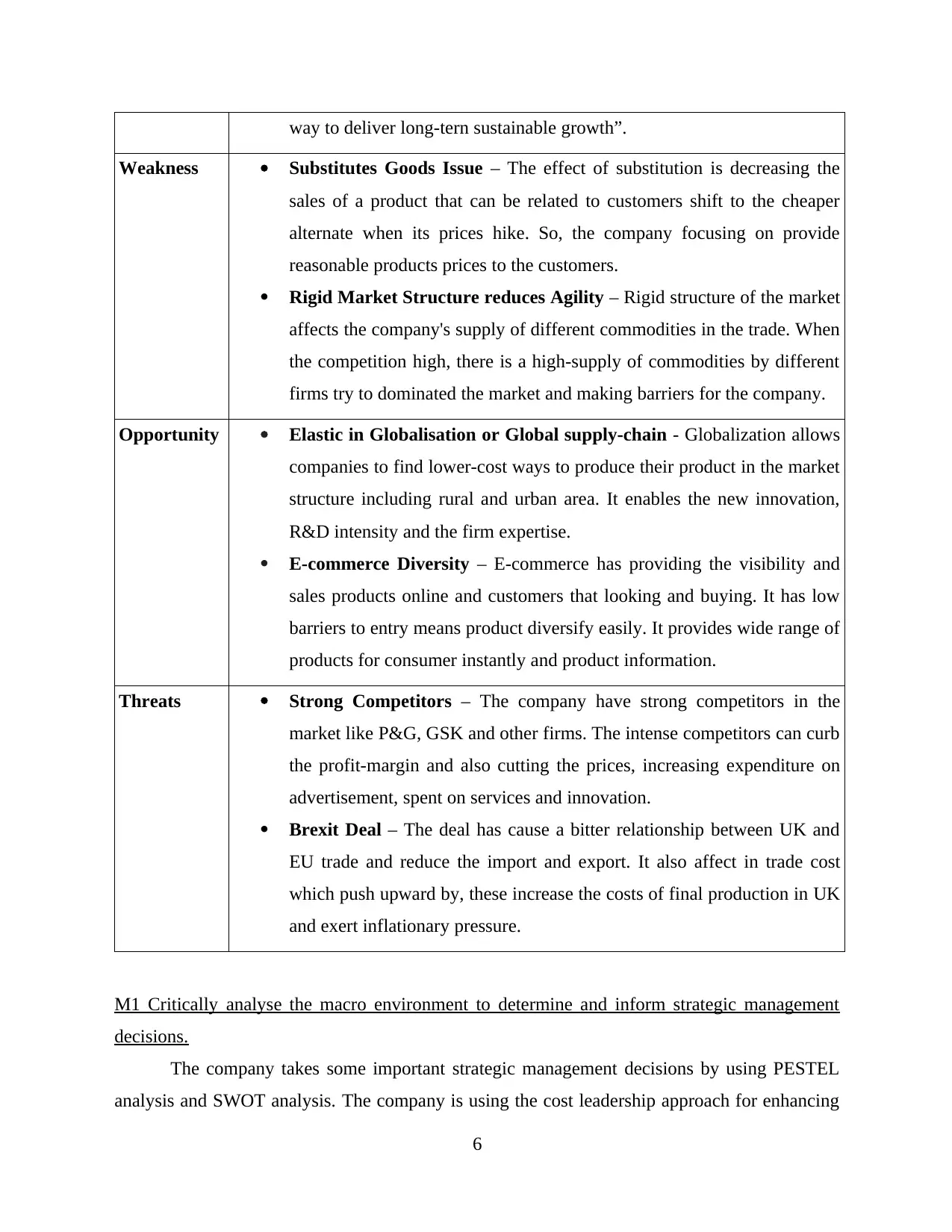
way to deliver long-tern sustainable growth”.
Weakness Substitutes Goods Issue – The effect of substitution is decreasing the
sales of a product that can be related to customers shift to the cheaper
alternate when its prices hike. So, the company focusing on provide
reasonable products prices to the customers.
Rigid Market Structure reduces Agility – Rigid structure of the market
affects the company's supply of different commodities in the trade. When
the competition high, there is a high-supply of commodities by different
firms try to dominated the market and making barriers for the company.
Opportunity Elastic in Globalisation or Global supply-chain - Globalization allows
companies to find lower-cost ways to produce their product in the market
structure including rural and urban area. It enables the new innovation,
R&D intensity and the firm expertise.
E-commerce Diversity – E-commerce has providing the visibility and
sales products online and customers that looking and buying. It has low
barriers to entry means product diversify easily. It provides wide range of
products for consumer instantly and product information.
Threats Strong Competitors – The company have strong competitors in the
market like P&G, GSK and other firms. The intense competitors can curb
the profit-margin and also cutting the prices, increasing expenditure on
advertisement, spent on services and innovation.
Brexit Deal – The deal has cause a bitter relationship between UK and
EU trade and reduce the import and export. It also affect in trade cost
which push upward by, these increase the costs of final production in UK
and exert inflationary pressure.
M1 Critically analyse the macro environment to determine and inform strategic management
decisions.
The company takes some important strategic management decisions by using PESTEL
analysis and SWOT analysis. The company is using the cost leadership approach for enhancing
6
Weakness Substitutes Goods Issue – The effect of substitution is decreasing the
sales of a product that can be related to customers shift to the cheaper
alternate when its prices hike. So, the company focusing on provide
reasonable products prices to the customers.
Rigid Market Structure reduces Agility – Rigid structure of the market
affects the company's supply of different commodities in the trade. When
the competition high, there is a high-supply of commodities by different
firms try to dominated the market and making barriers for the company.
Opportunity Elastic in Globalisation or Global supply-chain - Globalization allows
companies to find lower-cost ways to produce their product in the market
structure including rural and urban area. It enables the new innovation,
R&D intensity and the firm expertise.
E-commerce Diversity – E-commerce has providing the visibility and
sales products online and customers that looking and buying. It has low
barriers to entry means product diversify easily. It provides wide range of
products for consumer instantly and product information.
Threats Strong Competitors – The company have strong competitors in the
market like P&G, GSK and other firms. The intense competitors can curb
the profit-margin and also cutting the prices, increasing expenditure on
advertisement, spent on services and innovation.
Brexit Deal – The deal has cause a bitter relationship between UK and
EU trade and reduce the import and export. It also affect in trade cost
which push upward by, these increase the costs of final production in UK
and exert inflationary pressure.
M1 Critically analyse the macro environment to determine and inform strategic management
decisions.
The company takes some important strategic management decisions by using PESTEL
analysis and SWOT analysis. The company is using the cost leadership approach for enhancing
6
⊘ This is a preview!⊘
Do you want full access?
Subscribe today to unlock all pages.

Trusted by 1+ million students worldwide
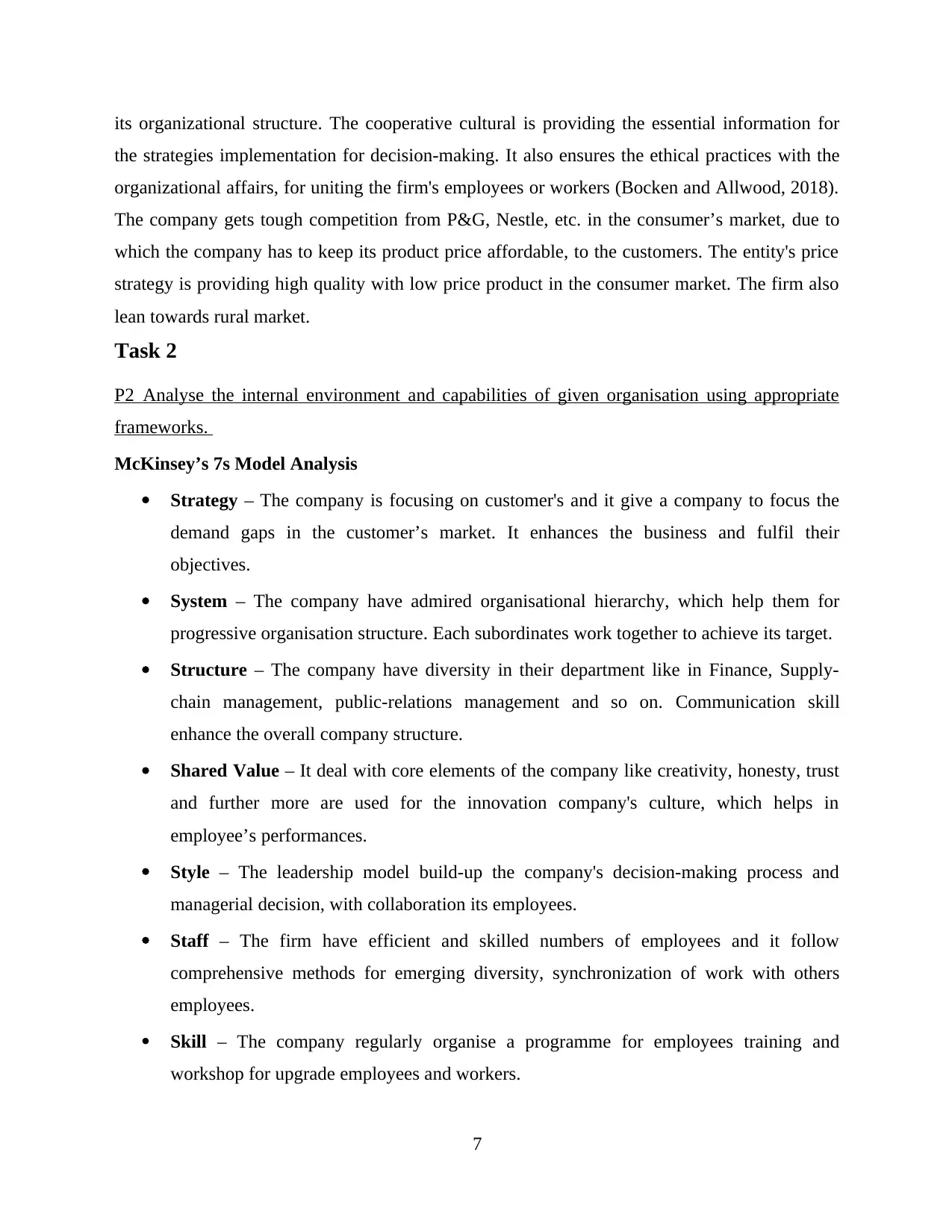
its organizational structure. The cooperative cultural is providing the essential information for
the strategies implementation for decision-making. It also ensures the ethical practices with the
organizational affairs, for uniting the firm's employees or workers (Bocken and Allwood, 2018).
The company gets tough competition from P&G, Nestle, etc. in the consumer’s market, due to
which the company has to keep its product price affordable, to the customers. The entity's price
strategy is providing high quality with low price product in the consumer market. The firm also
lean towards rural market.
Task 2
P2 Analyse the internal environment and capabilities of given organisation using appropriate
frameworks.
McKinsey’s 7s Model Analysis
Strategy – The company is focusing on customer's and it give a company to focus the
demand gaps in the customer’s market. It enhances the business and fulfil their
objectives.
System – The company have admired organisational hierarchy, which help them for
progressive organisation structure. Each subordinates work together to achieve its target.
Structure – The company have diversity in their department like in Finance, Supply-
chain management, public-relations management and so on. Communication skill
enhance the overall company structure.
Shared Value – It deal with core elements of the company like creativity, honesty, trust
and further more are used for the innovation company's culture, which helps in
employee’s performances.
Style – The leadership model build-up the company's decision-making process and
managerial decision, with collaboration its employees.
Staff – The firm have efficient and skilled numbers of employees and it follow
comprehensive methods for emerging diversity, synchronization of work with others
employees.
Skill – The company regularly organise a programme for employees training and
workshop for upgrade employees and workers.
7
the strategies implementation for decision-making. It also ensures the ethical practices with the
organizational affairs, for uniting the firm's employees or workers (Bocken and Allwood, 2018).
The company gets tough competition from P&G, Nestle, etc. in the consumer’s market, due to
which the company has to keep its product price affordable, to the customers. The entity's price
strategy is providing high quality with low price product in the consumer market. The firm also
lean towards rural market.
Task 2
P2 Analyse the internal environment and capabilities of given organisation using appropriate
frameworks.
McKinsey’s 7s Model Analysis
Strategy – The company is focusing on customer's and it give a company to focus the
demand gaps in the customer’s market. It enhances the business and fulfil their
objectives.
System – The company have admired organisational hierarchy, which help them for
progressive organisation structure. Each subordinates work together to achieve its target.
Structure – The company have diversity in their department like in Finance, Supply-
chain management, public-relations management and so on. Communication skill
enhance the overall company structure.
Shared Value – It deal with core elements of the company like creativity, honesty, trust
and further more are used for the innovation company's culture, which helps in
employee’s performances.
Style – The leadership model build-up the company's decision-making process and
managerial decision, with collaboration its employees.
Staff – The firm have efficient and skilled numbers of employees and it follow
comprehensive methods for emerging diversity, synchronization of work with others
employees.
Skill – The company regularly organise a programme for employees training and
workshop for upgrade employees and workers.
7
Paraphrase This Document
Need a fresh take? Get an instant paraphrase of this document with our AI Paraphraser
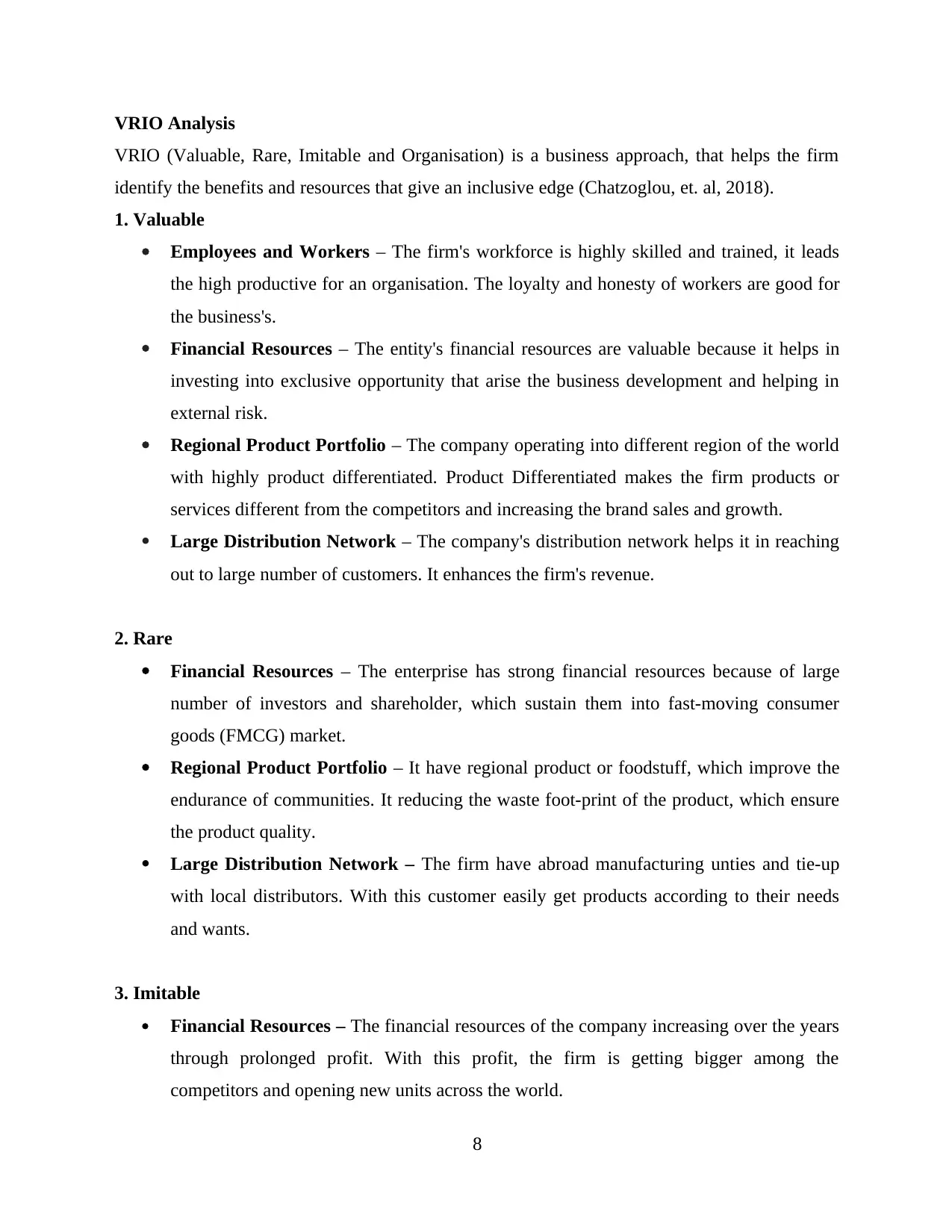
VRIO Analysis
VRIO (Valuable, Rare, Imitable and Organisation) is a business approach, that helps the firm
identify the benefits and resources that give an inclusive edge (Chatzoglou, et. al, 2018).
1. Valuable
Employees and Workers – The firm's workforce is highly skilled and trained, it leads
the high productive for an organisation. The loyalty and honesty of workers are good for
the business's.
Financial Resources – The entity's financial resources are valuable because it helps in
investing into exclusive opportunity that arise the business development and helping in
external risk.
Regional Product Portfolio – The company operating into different region of the world
with highly product differentiated. Product Differentiated makes the firm products or
services different from the competitors and increasing the brand sales and growth.
Large Distribution Network – The company's distribution network helps it in reaching
out to large number of customers. It enhances the firm's revenue.
2. Rare
Financial Resources – The enterprise has strong financial resources because of large
number of investors and shareholder, which sustain them into fast-moving consumer
goods (FMCG) market.
Regional Product Portfolio – It have regional product or foodstuff, which improve the
endurance of communities. It reducing the waste foot-print of the product, which ensure
the product quality.
Large Distribution Network – The firm have abroad manufacturing unties and tie-up
with local distributors. With this customer easily get products according to their needs
and wants.
3. Imitable
Financial Resources – The financial resources of the company increasing over the years
through prolonged profit. With this profit, the firm is getting bigger among the
competitors and opening new units across the world.
8
VRIO (Valuable, Rare, Imitable and Organisation) is a business approach, that helps the firm
identify the benefits and resources that give an inclusive edge (Chatzoglou, et. al, 2018).
1. Valuable
Employees and Workers – The firm's workforce is highly skilled and trained, it leads
the high productive for an organisation. The loyalty and honesty of workers are good for
the business's.
Financial Resources – The entity's financial resources are valuable because it helps in
investing into exclusive opportunity that arise the business development and helping in
external risk.
Regional Product Portfolio – The company operating into different region of the world
with highly product differentiated. Product Differentiated makes the firm products or
services different from the competitors and increasing the brand sales and growth.
Large Distribution Network – The company's distribution network helps it in reaching
out to large number of customers. It enhances the firm's revenue.
2. Rare
Financial Resources – The enterprise has strong financial resources because of large
number of investors and shareholder, which sustain them into fast-moving consumer
goods (FMCG) market.
Regional Product Portfolio – It have regional product or foodstuff, which improve the
endurance of communities. It reducing the waste foot-print of the product, which ensure
the product quality.
Large Distribution Network – The firm have abroad manufacturing unties and tie-up
with local distributors. With this customer easily get products according to their needs
and wants.
3. Imitable
Financial Resources – The financial resources of the company increasing over the years
through prolonged profit. With this profit, the firm is getting bigger among the
competitors and opening new units across the world.
8
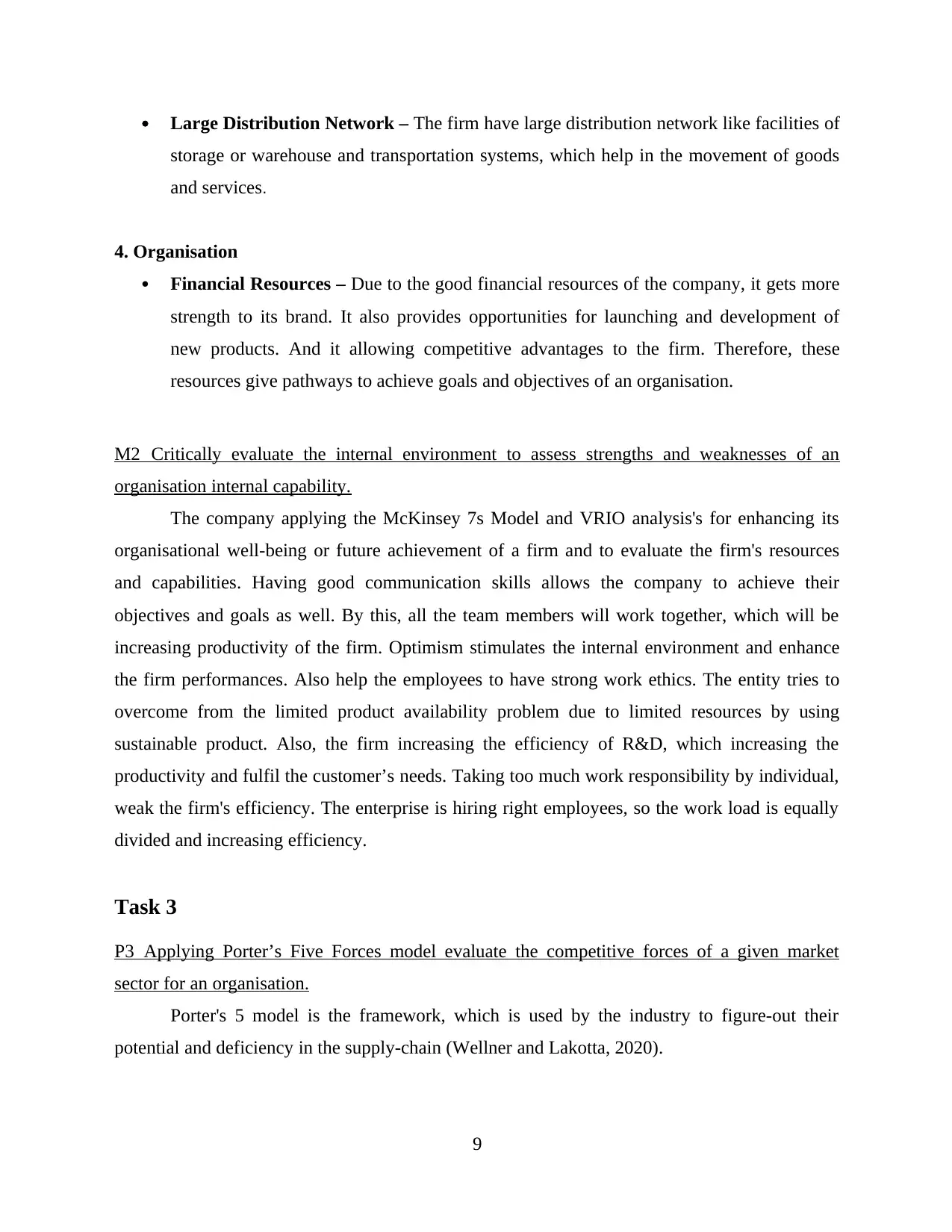
Large Distribution Network – The firm have large distribution network like facilities of
storage or warehouse and transportation systems, which help in the movement of goods
and services.
4. Organisation
Financial Resources – Due to the good financial resources of the company, it gets more
strength to its brand. It also provides opportunities for launching and development of
new products. And it allowing competitive advantages to the firm. Therefore, these
resources give pathways to achieve goals and objectives of an organisation.
M2 Critically evaluate the internal environment to assess strengths and weaknesses of an
organisation internal capability.
The company applying the McKinsey 7s Model and VRIO analysis's for enhancing its
organisational well-being or future achievement of a firm and to evaluate the firm's resources
and capabilities. Having good communication skills allows the company to achieve their
objectives and goals as well. By this, all the team members will work together, which will be
increasing productivity of the firm. Optimism stimulates the internal environment and enhance
the firm performances. Also help the employees to have strong work ethics. The entity tries to
overcome from the limited product availability problem due to limited resources by using
sustainable product. Also, the firm increasing the efficiency of R&D, which increasing the
productivity and fulfil the customer’s needs. Taking too much work responsibility by individual,
weak the firm's efficiency. The enterprise is hiring right employees, so the work load is equally
divided and increasing efficiency.
Task 3
P3 Applying Porter’s Five Forces model evaluate the competitive forces of a given market
sector for an organisation.
Porter's 5 model is the framework, which is used by the industry to figure-out their
potential and deficiency in the supply-chain (Wellner and Lakotta, 2020).
9
storage or warehouse and transportation systems, which help in the movement of goods
and services.
4. Organisation
Financial Resources – Due to the good financial resources of the company, it gets more
strength to its brand. It also provides opportunities for launching and development of
new products. And it allowing competitive advantages to the firm. Therefore, these
resources give pathways to achieve goals and objectives of an organisation.
M2 Critically evaluate the internal environment to assess strengths and weaknesses of an
organisation internal capability.
The company applying the McKinsey 7s Model and VRIO analysis's for enhancing its
organisational well-being or future achievement of a firm and to evaluate the firm's resources
and capabilities. Having good communication skills allows the company to achieve their
objectives and goals as well. By this, all the team members will work together, which will be
increasing productivity of the firm. Optimism stimulates the internal environment and enhance
the firm performances. Also help the employees to have strong work ethics. The entity tries to
overcome from the limited product availability problem due to limited resources by using
sustainable product. Also, the firm increasing the efficiency of R&D, which increasing the
productivity and fulfil the customer’s needs. Taking too much work responsibility by individual,
weak the firm's efficiency. The enterprise is hiring right employees, so the work load is equally
divided and increasing efficiency.
Task 3
P3 Applying Porter’s Five Forces model evaluate the competitive forces of a given market
sector for an organisation.
Porter's 5 model is the framework, which is used by the industry to figure-out their
potential and deficiency in the supply-chain (Wellner and Lakotta, 2020).
9
⊘ This is a preview!⊘
Do you want full access?
Subscribe today to unlock all pages.

Trusted by 1+ million students worldwide
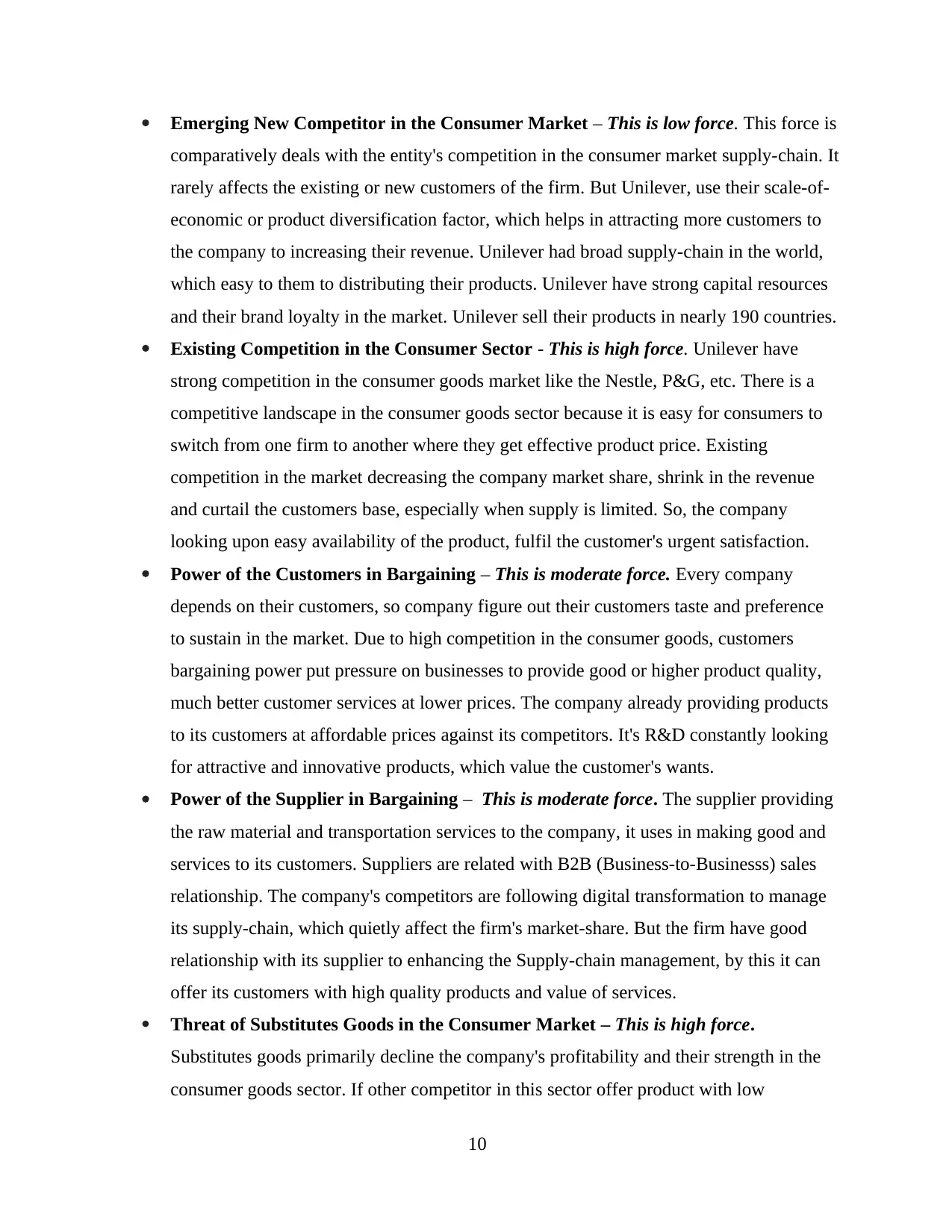
Emerging New Competitor in the Consumer Market – This is low force. This force is
comparatively deals with the entity's competition in the consumer market supply-chain. It
rarely affects the existing or new customers of the firm. But Unilever, use their scale-of-
economic or product diversification factor, which helps in attracting more customers to
the company to increasing their revenue. Unilever had broad supply-chain in the world,
which easy to them to distributing their products. Unilever have strong capital resources
and their brand loyalty in the market. Unilever sell their products in nearly 190 countries.
Existing Competition in the Consumer Sector - This is high force. Unilever have
strong competition in the consumer goods market like the Nestle, P&G, etc. There is a
competitive landscape in the consumer goods sector because it is easy for consumers to
switch from one firm to another where they get effective product price. Existing
competition in the market decreasing the company market share, shrink in the revenue
and curtail the customers base, especially when supply is limited. So, the company
looking upon easy availability of the product, fulfil the customer's urgent satisfaction.
Power of the Customers in Bargaining – This is moderate force. Every company
depends on their customers, so company figure out their customers taste and preference
to sustain in the market. Due to high competition in the consumer goods, customers
bargaining power put pressure on businesses to provide good or higher product quality,
much better customer services at lower prices. The company already providing products
to its customers at affordable prices against its competitors. It's R&D constantly looking
for attractive and innovative products, which value the customer's wants.
Power of the Supplier in Bargaining – This is moderate force. The supplier providing
the raw material and transportation services to the company, it uses in making good and
services to its customers. Suppliers are related with B2B (Business-to-Businesss) sales
relationship. The company's competitors are following digital transformation to manage
its supply-chain, which quietly affect the firm's market-share. But the firm have good
relationship with its supplier to enhancing the Supply-chain management, by this it can
offer its customers with high quality products and value of services.
Threat of Substitutes Goods in the Consumer Market – This is high force.
Substitutes goods primarily decline the company's profitability and their strength in the
consumer goods sector. If other competitor in this sector offer product with low
10
comparatively deals with the entity's competition in the consumer market supply-chain. It
rarely affects the existing or new customers of the firm. But Unilever, use their scale-of-
economic or product diversification factor, which helps in attracting more customers to
the company to increasing their revenue. Unilever had broad supply-chain in the world,
which easy to them to distributing their products. Unilever have strong capital resources
and their brand loyalty in the market. Unilever sell their products in nearly 190 countries.
Existing Competition in the Consumer Sector - This is high force. Unilever have
strong competition in the consumer goods market like the Nestle, P&G, etc. There is a
competitive landscape in the consumer goods sector because it is easy for consumers to
switch from one firm to another where they get effective product price. Existing
competition in the market decreasing the company market share, shrink in the revenue
and curtail the customers base, especially when supply is limited. So, the company
looking upon easy availability of the product, fulfil the customer's urgent satisfaction.
Power of the Customers in Bargaining – This is moderate force. Every company
depends on their customers, so company figure out their customers taste and preference
to sustain in the market. Due to high competition in the consumer goods, customers
bargaining power put pressure on businesses to provide good or higher product quality,
much better customer services at lower prices. The company already providing products
to its customers at affordable prices against its competitors. It's R&D constantly looking
for attractive and innovative products, which value the customer's wants.
Power of the Supplier in Bargaining – This is moderate force. The supplier providing
the raw material and transportation services to the company, it uses in making good and
services to its customers. Suppliers are related with B2B (Business-to-Businesss) sales
relationship. The company's competitors are following digital transformation to manage
its supply-chain, which quietly affect the firm's market-share. But the firm have good
relationship with its supplier to enhancing the Supply-chain management, by this it can
offer its customers with high quality products and value of services.
Threat of Substitutes Goods in the Consumer Market – This is high force.
Substitutes goods primarily decline the company's profitability and their strength in the
consumer goods sector. If other competitor in this sector offer product with low
10
Paraphrase This Document
Need a fresh take? Get an instant paraphrase of this document with our AI Paraphraser
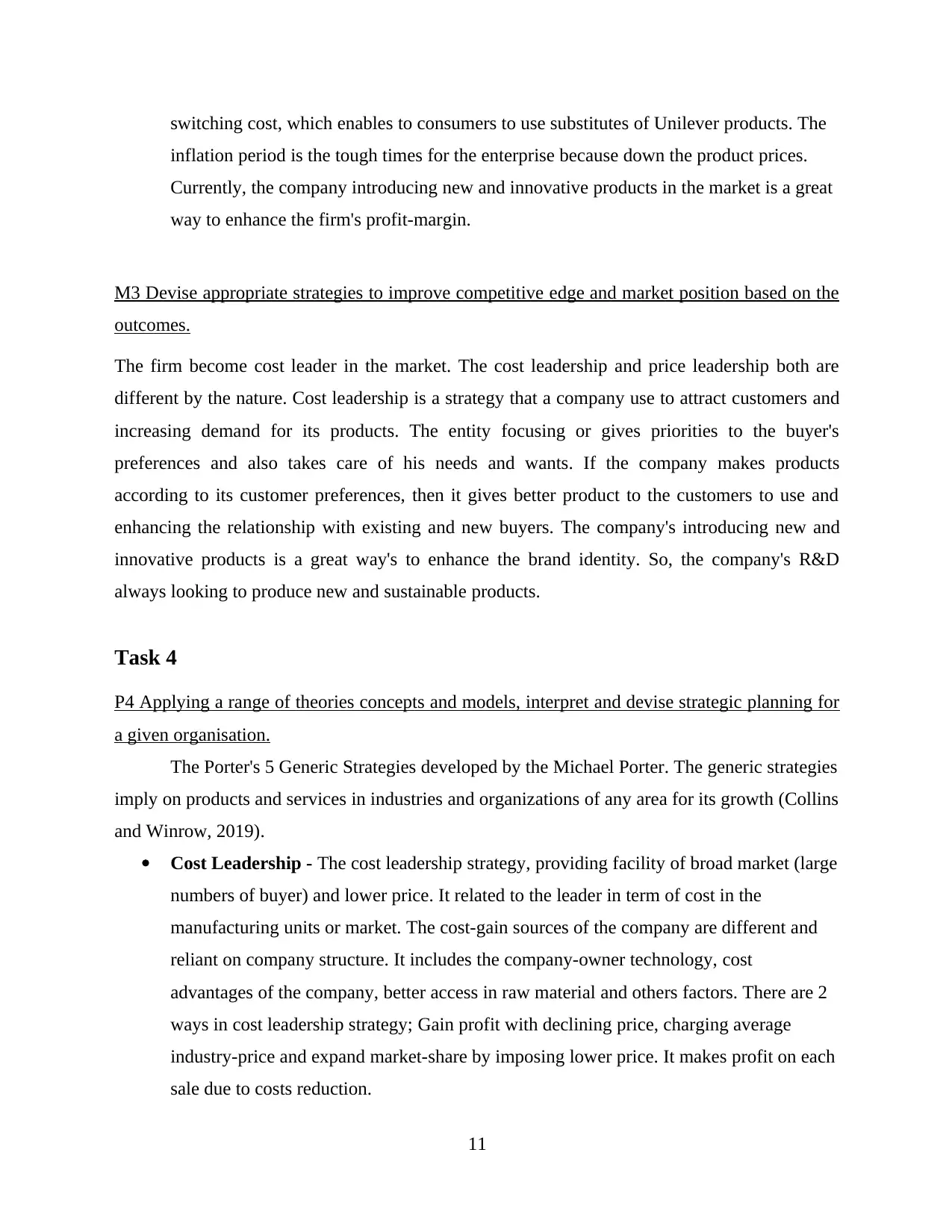
switching cost, which enables to consumers to use substitutes of Unilever products. The
inflation period is the tough times for the enterprise because down the product prices.
Currently, the company introducing new and innovative products in the market is a great
way to enhance the firm's profit-margin.
M3 Devise appropriate strategies to improve competitive edge and market position based on the
outcomes.
The firm become cost leader in the market. The cost leadership and price leadership both are
different by the nature. Cost leadership is a strategy that a company use to attract customers and
increasing demand for its products. The entity focusing or gives priorities to the buyer's
preferences and also takes care of his needs and wants. If the company makes products
according to its customer preferences, then it gives better product to the customers to use and
enhancing the relationship with existing and new buyers. The company's introducing new and
innovative products is a great way's to enhance the brand identity. So, the company's R&D
always looking to produce new and sustainable products.
Task 4
P4 Applying a range of theories concepts and models, interpret and devise strategic planning for
a given organisation.
The Porter's 5 Generic Strategies developed by the Michael Porter. The generic strategies
imply on products and services in industries and organizations of any area for its growth (Collins
and Winrow, 2019).
Cost Leadership - The cost leadership strategy, providing facility of broad market (large
numbers of buyer) and lower price. It related to the leader in term of cost in the
manufacturing units or market. The cost-gain sources of the company are different and
reliant on company structure. It includes the company-owner technology, cost
advantages of the company, better access in raw material and others factors. There are 2
ways in cost leadership strategy; Gain profit with declining price, charging average
industry-price and expand market-share by imposing lower price. It makes profit on each
sale due to costs reduction.
11
inflation period is the tough times for the enterprise because down the product prices.
Currently, the company introducing new and innovative products in the market is a great
way to enhance the firm's profit-margin.
M3 Devise appropriate strategies to improve competitive edge and market position based on the
outcomes.
The firm become cost leader in the market. The cost leadership and price leadership both are
different by the nature. Cost leadership is a strategy that a company use to attract customers and
increasing demand for its products. The entity focusing or gives priorities to the buyer's
preferences and also takes care of his needs and wants. If the company makes products
according to its customer preferences, then it gives better product to the customers to use and
enhancing the relationship with existing and new buyers. The company's introducing new and
innovative products is a great way's to enhance the brand identity. So, the company's R&D
always looking to produce new and sustainable products.
Task 4
P4 Applying a range of theories concepts and models, interpret and devise strategic planning for
a given organisation.
The Porter's 5 Generic Strategies developed by the Michael Porter. The generic strategies
imply on products and services in industries and organizations of any area for its growth (Collins
and Winrow, 2019).
Cost Leadership - The cost leadership strategy, providing facility of broad market (large
numbers of buyer) and lower price. It related to the leader in term of cost in the
manufacturing units or market. The cost-gain sources of the company are different and
reliant on company structure. It includes the company-owner technology, cost
advantages of the company, better access in raw material and others factors. There are 2
ways in cost leadership strategy; Gain profit with declining price, charging average
industry-price and expand market-share by imposing lower price. It makes profit on each
sale due to costs reduction.
11
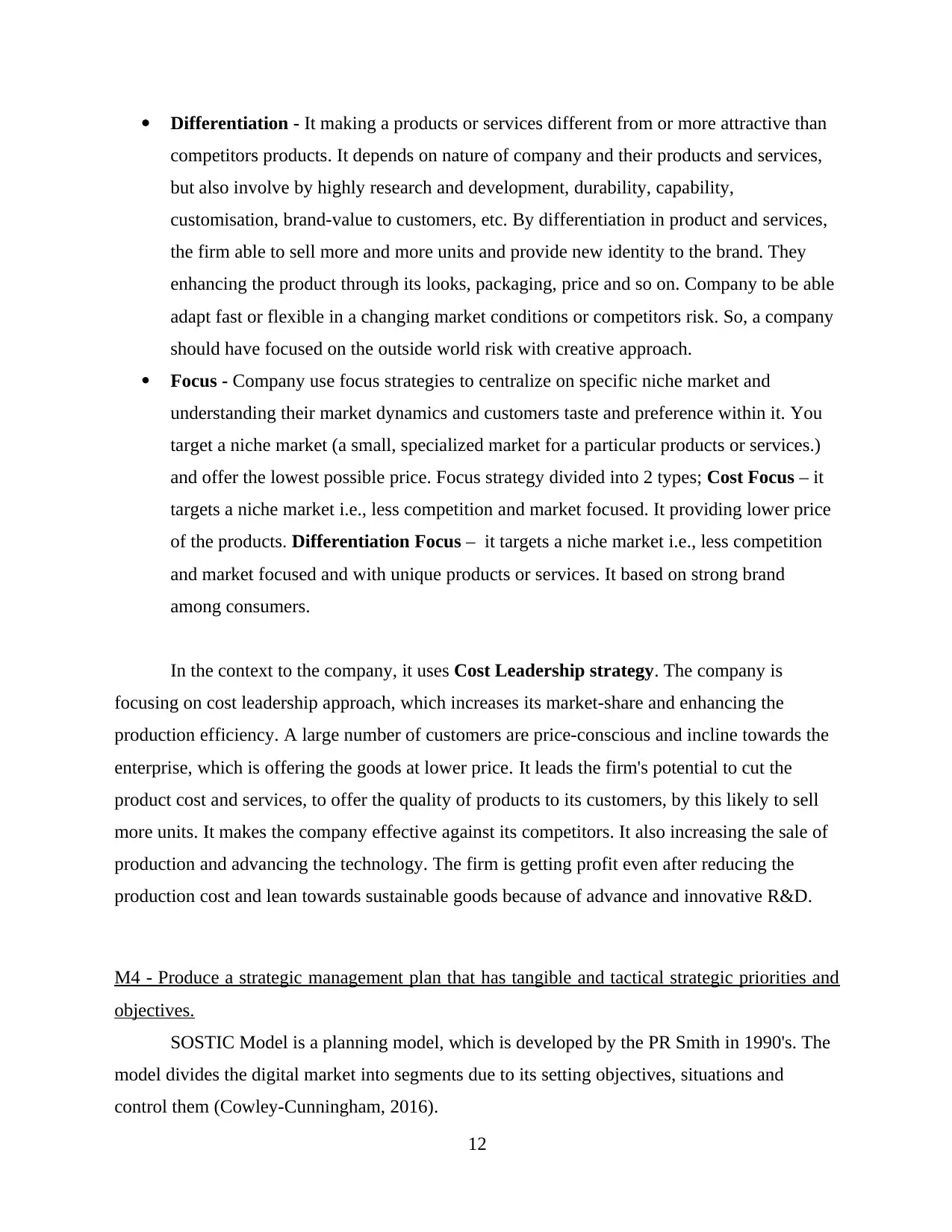
Differentiation - It making a products or services different from or more attractive than
competitors products. It depends on nature of company and their products and services,
but also involve by highly research and development, durability, capability,
customisation, brand-value to customers, etc. By differentiation in product and services,
the firm able to sell more and more units and provide new identity to the brand. They
enhancing the product through its looks, packaging, price and so on. Company to be able
adapt fast or flexible in a changing market conditions or competitors risk. So, a company
should have focused on the outside world risk with creative approach.
Focus - Company use focus strategies to centralize on specific niche market and
understanding their market dynamics and customers taste and preference within it. You
target a niche market (a small, specialized market for a particular products or services.)
and offer the lowest possible price. Focus strategy divided into 2 types; Cost Focus – it
targets a niche market i.e., less competition and market focused. It providing lower price
of the products. Differentiation Focus – it targets a niche market i.e., less competition
and market focused and with unique products or services. It based on strong brand
among consumers.
In the context to the company, it uses Cost Leadership strategy. The company is
focusing on cost leadership approach, which increases its market-share and enhancing the
production efficiency. A large number of customers are price-conscious and incline towards the
enterprise, which is offering the goods at lower price. It leads the firm's potential to cut the
product cost and services, to offer the quality of products to its customers, by this likely to sell
more units. It makes the company effective against its competitors. It also increasing the sale of
production and advancing the technology. The firm is getting profit even after reducing the
production cost and lean towards sustainable goods because of advance and innovative R&D.
M4 - Produce a strategic management plan that has tangible and tactical strategic priorities and
objectives.
SOSTIC Model is a planning model, which is developed by the PR Smith in 1990's. The
model divides the digital market into segments due to its setting objectives, situations and
control them (Cowley-Cunningham, 2016).
12
competitors products. It depends on nature of company and their products and services,
but also involve by highly research and development, durability, capability,
customisation, brand-value to customers, etc. By differentiation in product and services,
the firm able to sell more and more units and provide new identity to the brand. They
enhancing the product through its looks, packaging, price and so on. Company to be able
adapt fast or flexible in a changing market conditions or competitors risk. So, a company
should have focused on the outside world risk with creative approach.
Focus - Company use focus strategies to centralize on specific niche market and
understanding their market dynamics and customers taste and preference within it. You
target a niche market (a small, specialized market for a particular products or services.)
and offer the lowest possible price. Focus strategy divided into 2 types; Cost Focus – it
targets a niche market i.e., less competition and market focused. It providing lower price
of the products. Differentiation Focus – it targets a niche market i.e., less competition
and market focused and with unique products or services. It based on strong brand
among consumers.
In the context to the company, it uses Cost Leadership strategy. The company is
focusing on cost leadership approach, which increases its market-share and enhancing the
production efficiency. A large number of customers are price-conscious and incline towards the
enterprise, which is offering the goods at lower price. It leads the firm's potential to cut the
product cost and services, to offer the quality of products to its customers, by this likely to sell
more units. It makes the company effective against its competitors. It also increasing the sale of
production and advancing the technology. The firm is getting profit even after reducing the
production cost and lean towards sustainable goods because of advance and innovative R&D.
M4 - Produce a strategic management plan that has tangible and tactical strategic priorities and
objectives.
SOSTIC Model is a planning model, which is developed by the PR Smith in 1990's. The
model divides the digital market into segments due to its setting objectives, situations and
control them (Cowley-Cunningham, 2016).
12
⊘ This is a preview!⊘
Do you want full access?
Subscribe today to unlock all pages.

Trusted by 1+ million students worldwide
1 out of 18
Related Documents
Your All-in-One AI-Powered Toolkit for Academic Success.
+13062052269
info@desklib.com
Available 24*7 on WhatsApp / Email
![[object Object]](/_next/static/media/star-bottom.7253800d.svg)
Unlock your academic potential
Copyright © 2020–2025 A2Z Services. All Rights Reserved. Developed and managed by ZUCOL.


